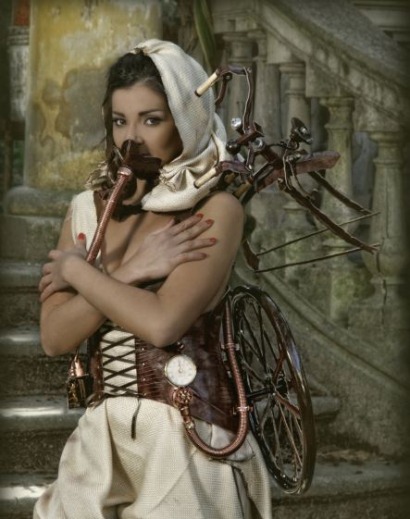
Among them is the design pictured above, which the designer describes as a statement on the dangers associated with climate change the need to adopt a clean-energy future.
"The idea is to enhance the female body not only in the beauty of its forms but also as a form of communication through the clothes," Bilancio explains. "My goal is to transform an outfit worn by woman into a positive message directed towards others.
"I give the woman the task and the merit of being superior to humans in ameliorating or solving problems," he says.
Bilancio's artistic efforts come as the Italian solar power industry continues to adjust to an updated feed-in tariff signed into law last year.
In May 2011, the Italian government revamped the nation's tariff regime, ultimately adopting a measure called Conto Energia 4 that will remain in effect through 2016.
It includes an array of incentives and restrictions on the solar technologies that can be deployed in the country, notably a 23 GW cap on development over the next four years and an annual support ceiling of €7 billion.
Through the incentive program the government is also trying to shift the industry's focus from large, ground-mounted solar farms to distributed, rooftop installations.
The policy regime also notably includes a 10 percent incentive for projects that have at least 60 percent European content.
The so-called "Made in the EU" provision has cheered some as a long-needed response to China's flooding solar markets around the world with cheap PV panels.
France is reportedly now considering adoption of a similar policy.
But in Italy the policy is already being criticized as a) too little too late, and b) misguided because the biggest players in the Italian solar sector aren't homegrown manufacturers, who would be hurt by the Chinese imports, but solar panel sellers and installers who actually benefit by having less expensive products to sell to consumers.
Bilancio hasn't weighed into specific energy sectors or debates over renewable energy policy just yet, explaining that to date he's preferred to work in broader themes.
"I work in social themes, trying to highlight and solve problems in the uncertain circumstances in which we find ourselves," he says.
Other designs include representations of the love/hate relationship any have with the contemporary city, and equality among people.
Next up, he says, is an outfit representing the life of Jesus of Nazareth and another, representing the passion of Christ.
"I'm doing it because people say they believe in Christ but do not appear to actually respect his teachings and messages," Bilancio says.
For additional information:

